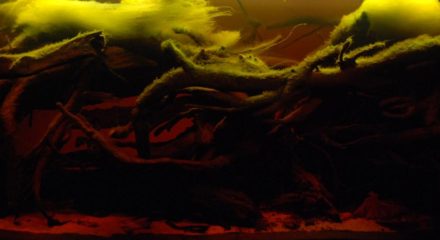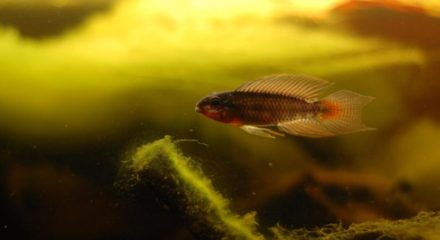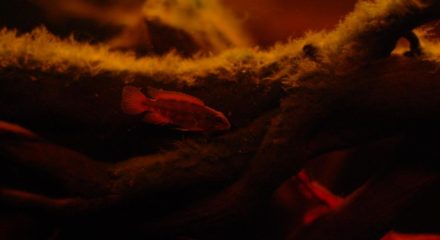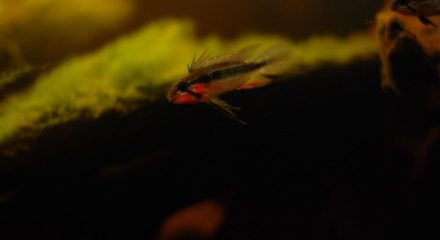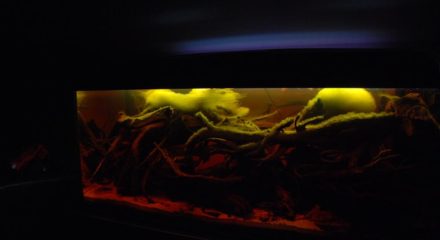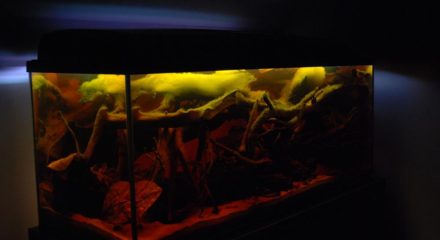Black Water, Rio Negro, Brasil
59th place in Biotope Aquarium Design Contest 2016
![]() Poland. Arkadiusz Skrzycki
Poland. Arkadiusz Skrzycki
Aquarium Volume: 160 L
Fish and invertebrates: Apistogramma uaupesi, Apistogramma elisabethae
Plants list: algae
Biotope description: The black waters of South America have a tint of tea color, they are very clear (visibility up to 3 meters), very acidic to moderate (pH between 3.5 and 6) and extremely soft. It contains trace amounts of chemical compounds. You can tell that they are almost sterile. The color and composition of the water results due to lack of non-leaching mineral substances from rocks present in the upstream and deposition in the water huge amounts of organic substances. These are mainly leaves and fruits falling from the trees and washed away during the rainy season. They rot and give off tannins and humic acids – substances that strongly acidify and color the water brown. The bottom of the ponds is generally sandy, but covered with a thick (20-30 cm) layer of decaying plant particles. There is a lot of rotten wood in the water. You will not find here almost any rocks or stones. To biotope black waters are classified as either running tanks and standing. The first of these is usually a slow flowing rivers including for example Rio Negro, Rio Cururu, Arapiuns Rio, Rio Tefe and their tributaries. Black water are also found in the bays and small water courses surrounded by jungle. In the black waters we can find a variety of fish bred in aquariums. There are species here both very small and very large, most of them belong to two families: tetras and cichlid. Naturally occurring Characin fish is usually small, very colorful gregarious species. Examples are the neon fish – both neon Innes (Paracheirodon innesi) and neon red (Paracheirodon axelrodi) come from the typical black waters. Most species of the genus Apistogramma (cichlids) comes from this habitat (eg. Apistogramma agassizi). Also discus, angelfish, Ramirez cichlids found here shelter.
Fish and invertebrates: Apistogramma uaupesi, Apistogramma elisabethae
Plants list: algae
Biotope description: The black waters of South America have a tint of tea color, they are very clear (visibility up to 3 meters), very acidic to moderate (pH between 3.5 and 6) and extremely soft. It contains trace amounts of chemical compounds. You can tell that they are almost sterile. The color and composition of the water results due to lack of non-leaching mineral substances from rocks present in the upstream and deposition in the water huge amounts of organic substances. These are mainly leaves and fruits falling from the trees and washed away during the rainy season. They rot and give off tannins and humic acids – substances that strongly acidify and color the water brown. The bottom of the ponds is generally sandy, but covered with a thick (20-30 cm) layer of decaying plant particles. There is a lot of rotten wood in the water. You will not find here almost any rocks or stones. To biotope black waters are classified as either running tanks and standing. The first of these is usually a slow flowing rivers including for example Rio Negro, Rio Cururu, Arapiuns Rio, Rio Tefe and their tributaries. Black water are also found in the bays and small water courses surrounded by jungle. In the black waters we can find a variety of fish bred in aquariums. There are species here both very small and very large, most of them belong to two families: tetras and cichlid. Naturally occurring Characin fish is usually small, very colorful gregarious species. Examples are the neon fish – both neon Innes (Paracheirodon innesi) and neon red (Paracheirodon axelrodi) come from the typical black waters. Most species of the genus Apistogramma (cichlids) comes from this habitat (eg. Apistogramma agassizi). Also discus, angelfish, Ramirez cichlids found here shelter.

